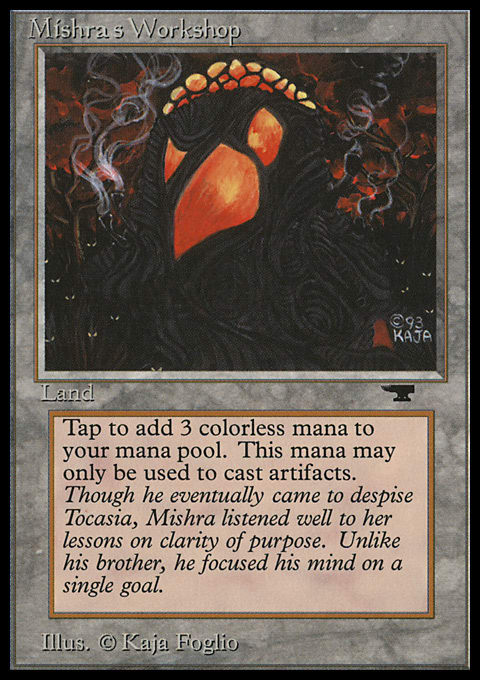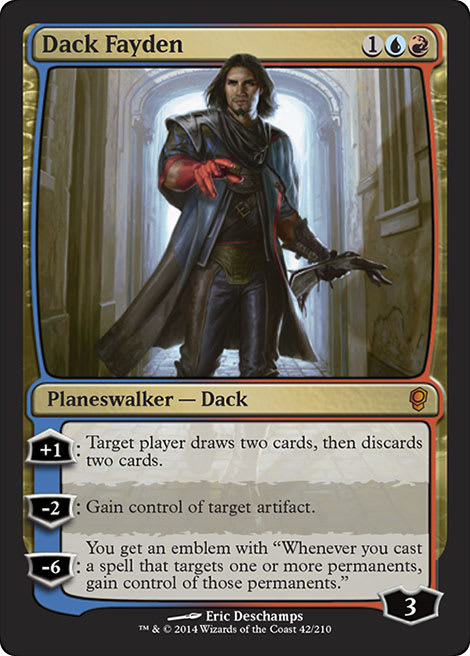Despite my horrible personal performance playing Magic: The Gathering, Eternal Weekend 2015 totally lived up to the hype. The turnout for Sunday’s Vintage Championship was 458 players, higher than most people would have guessed, making it the largest Vintage event in the mode. It surpassed the 2014 tally by more than one hundred. Thanks and praise to event organizer Nick Coss, Card Titan, and everyone who helped make a well run event and a great weekend.
Brian Kelly is the new Vintage Champion and won playing one of his creative and finely honed “Brian Kelly Decks,” an archetype that Vintage tournament organizers in the northeast created just for him when they couldn’t quite figure out how to classify his lists. In this case it was a Bomberman–Oath of Druids hybrid that included Dragonlord Dromoka as an answer to, well, everything. The impression among the Vintage community is that Kelly was very deserving of the honor and that it couldn’t have happened to a nicer guy.
I want to get to his deck and others later, though; there was too much going on to cover just the winners.
The weekend kicked off on Friday with an Old School ’93/’94 tournament hosted by Jason Jaco and Eternal Central. Deck construction rules are simple: “Decks may consist of cards from the sets Limited Edition Alpha, Limited Edition Beta, Unlimited Edition, Arabian Nights, Antiquities, Revised Edition, Legends, The Dark, and Fallen Empires. Additionally, for this tournament, we will allow Collector’s Edition Limited, Chronicles, and FBB (foreign black-bordered) reprints of these cards, but absolutely no foils and nothing in a new (e.g. modern) card frame.” There are a few other changes as well, including reinstituted mana-burn rules and legal (but restricted!) Chaos Orb.
The price of admission was a libation to the old gods of Magic: either a six-pack of craft beer or a bottle of good liquor (or soda or chips if you weren’t drinking), and they had a turnout of fifty-four players, including the likes of Stephen Menendian and Randy Buehler. Many classic decks show up—Mono-Black Control, R/G Aggro, U/R Counter-Burn, White Weenie, Keeper, The Deck, and so on—but there’s still some innovation to be found, as the level of Magic theory has developed so much over the decades.
In the end, Jeff Anand and Buehler were in the finals, playing The Hive Control and Keeper, respectively. Buehler took home the win with a crippling Amnesia.
Winner winner! Activated (my versions of) this card SO many times. It was glorious! GG in the finals Jeff Anand. pic.twitter.com/kYjlXBh2vT
— Randy Buehler (@rbuehler) August 22, 2015
After a team dinner on Friday, we drafted Sam Krohlow’s Onslaught Block Cube. It’s a great format with plenty of creature combat and effects thanks to the tribal theme and Legions in particular. Sam built it for the same reason I built the White-Bordered Wonder Cube of Fourth Edition and Chronicles: Those are the sets we started on, so they take us back to our early days in the game. I did well (winning my only matches of the weekend, come to think of it) with an R/G Beasts deck with some Elves and Forgotten Ancient. Ancient, as a 0/3 in a format built to deal with 2/2 more creatures, is exceptionally difficult for some decks to handle, but every time someone complained about losing to Babycakes, I could remind them, “Don’t blame me; you made the card!” On Saturday, rather than playing in the Legacy Championship, I opted to sleep in and do some touring (including the Muetter Museum of the College of Physicians of Philadelphia, which was truly interesting and highly recommended), but I had to hurry back to the convention center for an afternoon Vintage Artist Constructed tournament. Josh Krauser of Original Magic Art organized the event and was giving away an artist sketch of Simian Spirit Guide, from when it was originally concepted as Minotaur Spirit Guide.
Dan Frazier Mostly Mono-Black ? Vintage Artist Constructed | Nat Moes] [Creatures] 3 Xenic Poltergeist 1 Shapeshifter 3 Soldevi Simulacrum 4 Juggernaut [/Creatures] [Spells] 1 Berserk 4 Vendetta 2 Earthquake 4 Rhystic Tutor 1 Gloom 1 Aladdin's Ring 1 Disrupting Scepter 1 Forcefield 1 Jade Statue 1 Mox Emerald 1 Mox Jet 1 Mox Pearl 1 Mox Ruby 1 Mox Sapphire 1 Storm Cauldron 1 Sword of the Ages 1 Whirling Catapult 3 Mox Diamond 4 Powder Keg [/Spells] [Lands] 18 Swamp [/Lands] [Sideboard] 2 Disrupting Scepter 2 Death Bomb 2 Walking Dead 1 Soldevi Simulacrum 3 Gloom 2 Earthquake [/Sideboard] [/cardlist
Made it to 8 players for #mtgvac! 2 Greg Staples, Dave Kendall, Mark Tedin, @tnielsenart, Dan Frazier & Moeller pic.twitter.com/EakZL1zHP1 — Original Magic Art (@OriginalMtGArt) August 22, 2015
I like Vintage Artist Constructed quite a bit. Restrictions breed creativity, as they say, and there are some neat decks that pop up as players are forced to make some odd choices to stay with one artist. (For example, the Greg Staples and Christopher Moeller decks play Punishing Fire as a 2-mana Shock since they have no way to force life-gain.) More importantly, though, the slower speed of the format and some of the decks from what I would call “classic artists” like Frazier and Tedin hit a nostalgic nerve for me. The decks and games play out like games when I started back in 1995.
I’m going to plan on scheduling some Vintage Artist Constructed events in Ohio in the near future, so be warned (or let me know if you’re interested).
But enough about the charming, nostalgic formats. Vintage is a living thing with a lot going on right now. What can we learn from Champs?
First, the overall format looked surprisingly healthy. Walking around between matches and looking at the Top 32 lists showed a typical Vintage environment: mostly blue decks with Force of Will, about 30% Mishra's Workshop decks, about 10% Dredge decks, and a smattering of other things, especially combos of various types. For all the complaints about Workshops, it still put only two representatives into the Top 8 (two of the best players in the room, Rich Shay and Paul Mastriano), and neither one made the finals. There was an odd distribution in the Top 16, however, as seven of those decks were Workshops. That 43% representation is a little alarming, but the number does flatten out again as more decks are taken into consideration.
Monday-morning Vintage theorists can make of these numbers what they want. (And I hope there will be more lists and deeper breakdown available soon.) As I said, to me, the format looks normal. The bigger concern with Workshops is whether the games they create are “interactive” or, to put it simply, “fun.” Obviously, fun is a subjective concept, and some people go about it in different ways. One likes to set up complicated turn-one combos and storm turns that take several minutes to run through; another likes to control the game with counterspells, being the ultimate decider of an opponent’s actions; a third likes to prevent opponents from doing anything, taxing his or her spells into unplayability. They’re all ways to have fun in Vintage, and all of them are, to a degree, uninteractive.
I mean, that’s the goal of any Magic game: to take all of your opponent’s interactive opportunities away. That’s when your opponent loses.
But there are degrees of interactivity. When Workshops is on the play and starts with Sphere of Resistance and Chalice of the Void and then Wasteland and Thorn of Amethyst and then Lodestone Golem and then Tangle Wire, the opponent will have done literally nothing but watch someone goldfish a Vintage deck for several minutes. Magic is a game, and people come to play—or at least feel like they’re playing.
Is Vintage to the point that Workshop decks are so interactive that restrictions are necessary? Probably not. Again, as evidenced by Champs, non-Workshop decks are still the ones winning tournaments, and that’s not dumb luck. Players are becoming better at being more prepared for Workshops and being able to meet them on their own terms. There were many main-decked Dack Faydens and sideboarded Pulverizes at Champs. There were a lot of basic lands to dodge Wasteland. Mana bases in the winning decks were substantively larger than those in less successful ones, including three of the Top 8 blue decks that ran twenty-five mana sources post-’board. It appears that the beginning of a reluctant adjustment to Workshops’s power.
I’ll have a more thorough look at some of the interesting Top 32 decks, but there are some other notable points. For one, there were a lot of Magic Origins cards represented. In addition to the Hangarback Walkers making Workshop opponents and their Ingot Chewers and Pulverizes miserable, there were several combo decks with Day's Undoing (mostly losing if my experience is any indication); appearances of Jace, Vryn's Prodigy, in decks with Dig Through Time or Worldgorger Dragon combo; and Dark Petition making a new storm combo list that performed well. Magic Origins (like most core sets, in fact) had a lot of potentially playable cards for the format. I’m excited to see as more of these decks play out.
Along with new cards, I also met quite a few new players. Across from me at the player meeting was a young man from the Philly area who said he had always wanted to play in Champs and “threw a pile of jank together” to do so. Next to me in the first round (with all the good fortune of playing against Menendian) was another player at his second Vintage tournament and first Champs. My second-round opponent, too, was relatively new to the paper format, though not new to Magic, and he was inspired to buy in after playing Vintage online. He had traveled all the way from North Carolina by himself to play.
Having new people entering the format is wonderful to hear about since it will mean that Vintage keeps growing, despite the barriers to entry. There are still plenty of opportunities to play the format unsanctioned with some number of allowed proxies that can drastically reduce the buy-in.
As a warning to new players, make sure to check your decklist against the Vintage Banned and Restricted list. The judges I talked to didn’t report any counterfeit Power, but they did mention there was a Dredge deck running four Lion's Eye Diamonds, a Delver deck with four Brainstorms, and another Delver deck with four Brainstorms and four Ponders! Those are probably not the worst restricted-card-related mistakes I’ve heard of, but be careful, and double-check everything.
In the end, Eternal Weekend and the Vintage Championship for me was more about celebrating the game, the format, and the community, just as it was for most of the 458 Vintage players and 744 Legacy players. It was important for me to remember that half the attendees lost round one, and another quarter (more than one hundred players!) lost round two. When it comes to losing rounds three and four in a row, you’re in a pretty select group.
#TeamSerious? More like #TeamSpurious. #EternalWeekend pic.twitter.com/xUVY0vxbWh
— Grandpappy Belcher (@GrandpaBelcher) August 23, 2015
I’ll have more decklists and discussion in my next follow-up. Because this tournament is so large and so full of new things, I want to let things sink in before diving in after them.
Thanks for reading!
Nat Moes





























